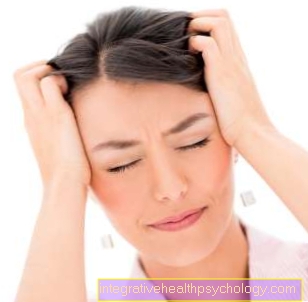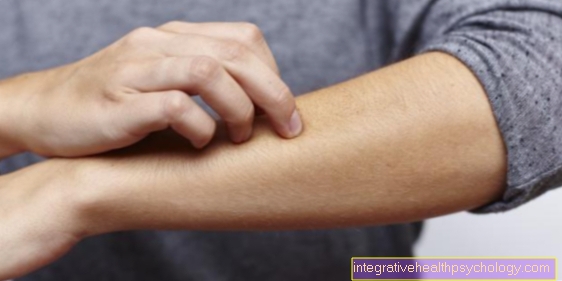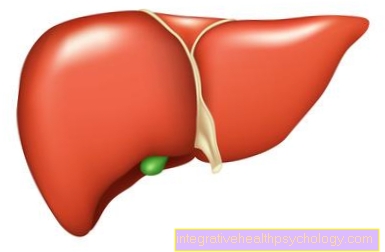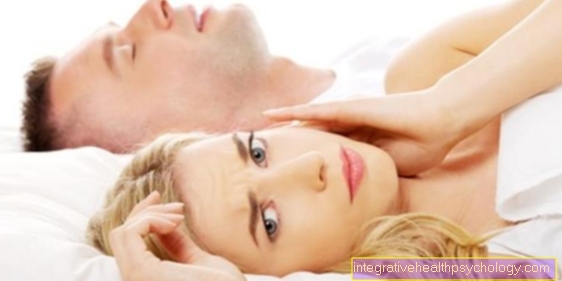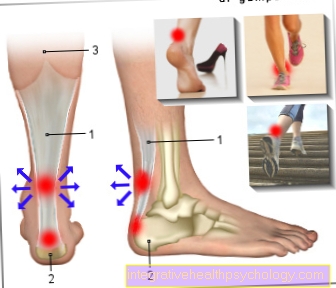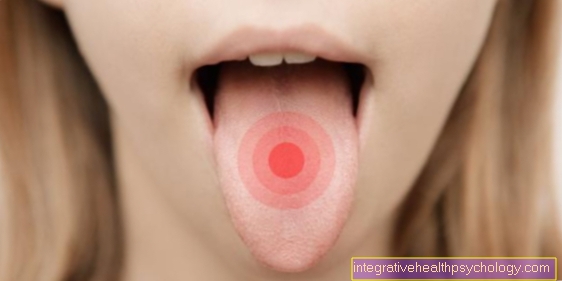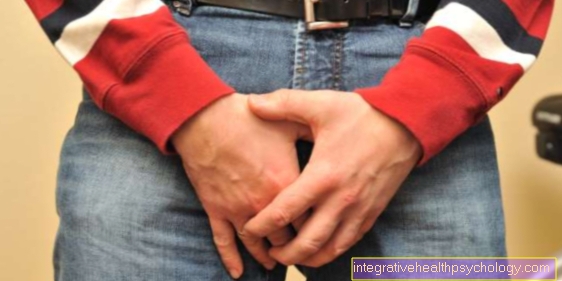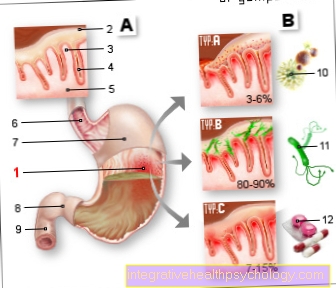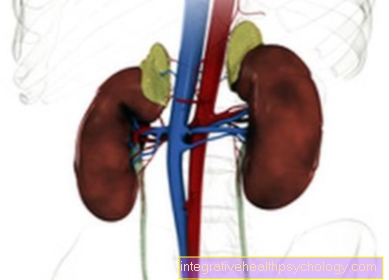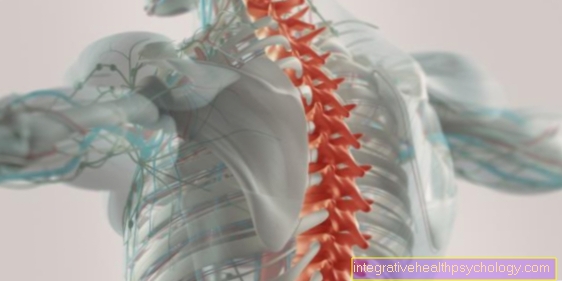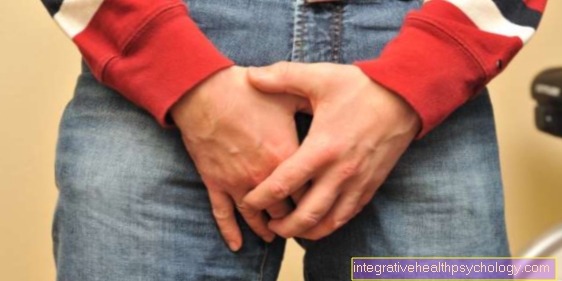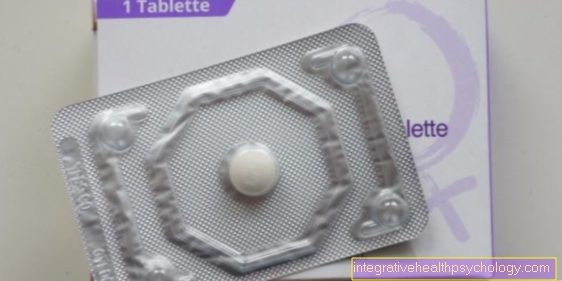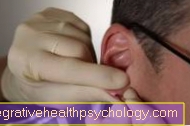Earache
synonym
Otalgia, earache
English: earache
definition
Earache refers to painful, often inflammatory complaints in the area of the ear.
Concomitant symptoms
With earache, numerous accompanying symptoms can occur, about the occurrence of which the doctor should be informed. This includes in the first place discharge from the diseased ear. This can be clear, purulent, or even bloody. Sometimes one makes one unpleasant smell noticeable. When the external auditory canal is inflamed, caused by the bacterium Pseudomonas aeruginosa, a typical odor occurs that is known as sweetish violet-like is described.
At far advanced inflammation can the auricle and the skin surrounding the ear reddened be. Another classic sign of inflammation often occurs overheat the skin and auricle. Occasionally exist Lymph node swelling in the head and neck area. Furthermore is fever a common side effect of many ear diseases, especially if they are caused by bacteria. If you have a febrile illness, you should definitely consult a doctor for the Need for antibiotic treatment to consider.
Find out more at: Inflammation of the auricle
Another common symptom of ear pain is that Hearing loss on the affected side. This can have various causes and usually subsides as the underlying disease subsides.
These are very unpleasant symptoms that occur in the context of various painful ear diseases dizziness and nausea. Due to the close anatomical relationships of the auditory and equilibrium organs, inflammation of the inner ear can also do that Semicircular canal system concern, which is responsible for the perception of the situation in space. This is typical for ear diseases Vertigo, which is characterized by the feeling that the environment is turning like on a carousel. You can do this jerky, horizontal movements of the eyeballs occur in medical terminology Nystagmus to be named.
It can also be less common Facial nerve be affected by inflammation. That sometimes leads to one unilateral weakness of the facial muscles. This symptom, which is very worrying for most patients, disappears in almost all cases within a few weeks.
to form
In principle, will primary earache from secondary earache distinguished.
Of the primary earache is caused by a disease of the ear. Secondary earache it can come, if not that Ear, but neighboring organs and structures are affected, and the pain is about corresponding Nerve fibers is directed into the ear. The following annoy can cause such a forwarding:
- Trigeminal nerve
- Facial nerve
- Glossopharyngeal nerve
- Vagus nerve
For example, diseases of the teeth, the parotid gland and the temporomandibular joint can trigger secondary earache.
Please also read our article on this Pain in jaw and ear.
In many cases, the primary earache is otitis media (Otitis media) as a fundamental disease. This is a painful inflammation of the lining of the middle ear that often follows inflammation of the upper respiratory tract. If there is a tear in the eardrum, pathogens can also penetrate the middle ear from the outside and also trigger an otitis media.
frequency
While adults usually go to the doctor for secondary ear pain, the cause of which is not directly in the ear, children in the vast majority of cases complain of one Otitis media as the causative factor. 3-6% of all visits to a general practitioner are caused by ear pain. Over the past 30 years, middle ear infections have almost tripled in frequency. By the age of three months, every tenth child has had an episode of otitis media. Of the Disease peaks lies between the 6th and 15th Month of life. Up to the age of 10, around 40% of children have had an otitis media.
causes
There are a number of conditions that can cause earache.
With an acute otitis media, earache sets in suddenly and unexpectedly. Most patients also complain of exhaustion, fever and irritability. Children in particular are very often affected by acute otitis media. They often go through several episodes of recurring otitis media. Here, too, there is usually a previous or ongoing infection of the upper respiratory tract.
By swelling of the corridors (Tubes) there is hearing impairment and outwardly bulging and reddened eardrum. If only one ear is affected, there could be a bacterial cause. The most common pathogens causing otitis media are the bacteria Streptococcus pneumoniae, Haemophilus influenzae and Moraxella catarrhalis. Viral pathogens are also discussed as a cause. In particular the viruses respiratory syncytial virus, parainfluenza virus, influenza virus and enterovirus seem to be causative pathogens. If there are three otitis media in half a year, one speaks of a recurrent otitis media.If an otitis media lasts for weeks or even months, it is called chronic otitis media.
Bacteria can also cause ear lobe pain by entering an open wound there.
Read more on this topic at:
- Pain in the earlobe.
- Pain ear
- Earache with a cold
Another cause of Earache can be a so-called Seromucotympanum be. This is a build-up of serous or mucosal fluid in the middle ear spaces with no evidence of purulent inflammation. Usually there is a bilateral feeling of pressure with hearing loss. With children there is a risk of linguistic developmental disorder. The cause is a mechanical narrowing caused by the Pharynx accepted. But infections of the upper respiratory tract are also discussed as a triggering factor.
The so-called Tubular catarrh arises either from infections of the upper respiratory tract or from rapid ascent to great heights (airplane) or descent to depths (diving). This leads to a closure of the auditory canals, resulting in insufficient ventilation, drawing in of the eardrum and fluid flowing into it Middle ear. Inflammation of the external ear canal and the outer ear can also cause earache. They are mostly caused by bacteria, fungi or allergies. Toxic substances can also cause a Inflammation of the outer ear (External otitis) come. Patients who frequently go to the swimming pool often complain of this disease. Certain cosmetics, shampoos, or nickel can cause a toxic otits externa The improper use of cotton swabs can lead to minor trauma and thereby to Earache come.
Ear canal furuncles (caused by bacterial Staphylococcus aureus infections) can lead to earache as well as that caused by streptococci Erysipelas of the skin in the area of the ear. While the patient usually also complains of a poor general condition and fever, this manifests itself Perichondritis (Inflammation of the ear cartilage) merely by a painful reddening and swelling.
Also severe general health disorders, as well fever and Redness of the ear are through a Mastoiditis triggered. This is where bacterial infection of the mastoid behind the ear occurs. In extreme cases, the swelling the ear moved. It comes to the finding of the protruding ear, what a absolute emergency represents.
also read: Swelling behind the ear.
Earache can also be caused by inflammation of the tonsils, parotid glands, thyroid glands, temporal arteritis or Pfeiffer's glandular fever.
In the case of ear pain that cannot be treated, the presence of ear tuberculosis or so-called Wegener's granulomatosis must also be considered.
Diseases of the intervertebral discs and muscular tension in the back of the neck can also trigger earache through the transmission of pain.
The so-called zoster oticus is caused by varicella zoster viruses that were caught several years earlier. Only a long time after the first infection do blisters appear on and around the ear, which can result in ear pain.
Suddenly shooting and lightning-like ear pain could be caused by trigeminal neuralgia. This is a nerve irritation of the trigeminal nerve with often very severe pain in this area. Foreign objects in the ear such as cotton swabs or excessive wax production (Cerumen) can lead to earache as well as hearing impairment. Furthermore, eardrum injuries after improper use of cotton swabs are common causes of earache. After corresponding accidents with subsequent severe earache, the suspicion of a fracture of a bone in this area must always be made. A fracture of the petrous bone would lead to hearing impairment and ear pain as well as bleeding from the ear.
Sialolithiasis is a salivary dysfunction that can also cause ear pain.
In the case of untreatable and long-lasting earache, the suspicion of a malignant tumor change in the area of the ear must always be made. The most common tumors in this area are:
- Nasopharyngeal carcinoma
- Basalioma
- Squamous cell carcinoma
- Spinalioma
- Acoustic neuroma
diagnosis
If you want to consult a doctor about an earache, you can first contact your family doctor. This will be sent to a ENT doctor transfer. The doctor first introduces Anamnesis interviewwhere the patient has the opportunity to describe his or her complaints. The time course, pain intensity and pain quality as well as any accompanying symptoms should be described in detail.
The conversation is usually followed by one physical examinationthat focuses on the head and neck area. The doctor will use a spatula and flashlight to inspect the mouth and palpate the local lymph nodes. The examination of the ear itself is carried out using an ear speculum and otoscope. The ear speculum is inserted into the outer part of the ear canal and enables a clear view of the eardrum. The ear canal and eardrum can be inspected with the otoscope, which resembles magnifying glasses. Both ears are always examined. If there is a discharge, smears can be made for the microbiological examination.
A Blood collection completes the investigation. It is checked whether certain inflammatory parameters in the blood are increased. In the case of certain diseases, the doctor can order an X-ray examination. These diseases include rather rare, chronic inflammations of the ear, which can sometimes attack the bone substance of the skull.
Duration
The most Ear diseases are uncomplicated and do not require any lengthy treatment. If the external auditory canal is inflamed, there will be a significant improvement after a few days with adequate therapy. The disease should completely heal after about 1-2 weeks. Also one Otitis media rarely lasts more than two weeks. In both diseases, however, stubborn and complicated courses are known, which can take a long time to heal. There are chronic forms of otitis media, which can take a long time to treat. In otitis media chronica epitympanalis, the skull bone is sometimes involved. In this case, an operation is necessary, which is associated with a long follow-up treatment.
Find out more about the acute and chronic otitis media
What to do?
First of all, any manipulation on or in the ear should be avoided. No objects may be inserted into the ear canal. First remedy for mild earache can be Heat applications procure. A cherry stone or gel pillow can be warmed up and placed on the ear. The temperature should not be too high, otherwise skin damage or even deterioration of the clinical picture will occur.
The application of heat and other home remedies may not help Painkiller come into use. A suitable drug is here Ibuprofen from the group of NSAIDs (non-steroidal anti-inflammatory drugs). If there is also a fever, may Paracetamol In addition to its good pain relieving properties, it also reduces fever. Decongestant nasal drops can support the healing process and alleviate the symptoms.
Mostly is no intake of Antibiotics required. These are given for bacterial infections when the disease is well advanced. As a rule, however, treatment without antibiotics is attempted, as many ear diseases have a high spontaneous healing rate. Antibiotics can also be given as an ointment for inflammation of the external ear canal.
Home remedies for earache
In addition to drug treatment of the ear disease on which the earache is based, homeopathic remedies also include tried and tested home remedies.
Read more on the topic: Home remedies for earache
However, it is important that not all home remedies have an effect on all causes: a correct and effective treatment of the earache is of the utmost importance, as incorrect therapy can have serious consequences (e.g. meningitis caused by spreading inflammation, loss of hearing, etc. ).
One of the best-known home remedies for earache are the so-called onion bags. Here, diced, briefly heated onions are wrapped in a clean cloth and placed on the ear up to three times a day for about an hour (and possibly fixed). The essential oils of the onion that develop in the process have an antibacterial and anti-inflammatory effect on the one hand, and expectorant and metabolism-stimulating on the other. The heat also has a pain-relieving effect.
Read more on this topic at: Medicinal plant onion.
Similar effects can also be achieved with finely chopped parsley or a mixed mustard flour paste wrapped in a cloth.
Read more on this topic at: Medicinal plant parsley.
Camomile steam baths have a similar effect. The ear is held over a pot of chamomile tea. This can be prepared using commercially available tea bags or fresh chamomile. To use the steam more effectively, it can help to cover your head with a towel above the pot. Chamomile is also said to have antibacterial and anti-inflammatory properties.
Also read: Medicinal plant chamomile.
Furthermore, irradiation of the ear with red light can relieve ear pain, but this should only be used if no inflammation of the ear is the cause (rather cold pads in the case of inflammation).
Globules / homeopathy
In addition to a purely medicinal therapy for earache, various homeopathic remedies are used.
Primarily in homeopathy:
- Allium cepa (Kitchen onion)
- Capsicum (black hot peppers)
- Aconitum napellus (Balaclava)
- Belladonna (Deadly nightshade)
- Chamomilla (chamomile)
- Ferrum phosphoricum (Iron phosphate
- Mercurius solubilis (homeopathic mercury)
- Pulsatilla pratensis (Pasque flower)
- Silicea (Silica)
and - various Schüssler salts
- No. 3 Ferrum phosphoricum
- No. 4 Kalium chloratum for acute inflammation
- No. 6 Kalium sulfuricum for purulent secretion from the ear
- No. 2 Calcium phosphoricum
- No. 11 Silicea for recurring ear infections)
used to treat ear pain. The exact remedy depends on the underlying cause of the earache.
The homeopathic remedies listed are usually in the Dosage potencies D6 and D12 in the form of Drops, tablets or globules administered several times a day. Some, however, also in low potencies D1 and D4.
Earache in children
Earache occur significantly in children compared to adults more often in front. Up to the age of 3 almost every child suffers from earache at least once, often in the context of one Otitis media occur. guys are often there more often affected as a girl.
The reason for this frequent occurrence of earache and otitis media in childhood lies in the anatomical peculiarity of the ear trumpet, which serve as a connection between the middle ear (Tympanic cavity) and nasopharynx is normally used to equalize pressure and drain secretion. On the one hand, it is initially even shorter in children and runs more horizontally, so that bacteria or Viruses easier with colds in the middle ear rising up can. On the other hand is the Eustachian tube even so closelythat it easily becomes a complete Clasp comes when the mucous membrane swells due to inflammation or a cold.
A Damming of non-draining secretion, offers an optimal fertile soil for the (over) settlement of Germinate (Bacteria or viruses) which can easily lead to an inflammatory infection of the middle ear (Otitis media). An inflammation of the middle ear and a swelling of the ear trumpet cause it to Fluid collects in the middle ear, multiplied pressure builds up and thereby the eardrum is bulged outwards, which is usually with Pain connected is.
Also the swelling and inflammation of the parotid gland, especially with the viral childhood disease mumps, can lead to earache in children.
Depending on the age of the affected child, the ear complaints can be localized and described more or less well and precisely.
Toddlers are often noticeable because they increase tearful are and often to the Rub ears. In addition, there may be general symptoms such as fever, diarrhea and Vomit, stomach pain and Hearing problems occur.
With existing Earache of the child, as a rule, should be the Pediatrician to get to the bottom of the cause and to treat it correctly in order to avoid possible, sometimes very serious complications (Meningitis, Eardrum perforation, hearing loss).
Earache in pregnancy
Earache in pregnant women can be basically the same causes like with non-pregnant women. Inflammation of the external ear canal or the middle ear occurs occasionally during pregnancy and is usually not a cause for concern. It does exist no imminent danger for the pregnant woman or for the unborn child.
Nevertheless, many expectant mothers are initially very unsettled. Although earache is a common symptom of mostly harmless diseases, women should definitely consult a doctor during pregnancy. The cause of the pain should be identified in good time and appropriate therapy initiated in order to prevent the disease from progressing and a possibly complicated course.
A dreaded complication otitis media is one Meningitis (meningitis), the intensive therapy of which is associated with certain risks for the unborn child. In general, the earlier therapy is initiated, the lower the need for medication and thus the burden on the fetus. Wherever treatment without additional medication is possible, this should be preferred in favor of the child. The doctor will decide this after carefully weighing the risks and benefits. Your doctor can also help you choose the right medication, even if you are pregnant.
Also read: Medication during pregnancy
Ear pain with a cold
Occur earache as part of a cold on, they are often on one acute otitis media (Otitis media), which arises from the fact that germs - especially bacteria and viruses - rise from the nasopharynx via the ear trumpet (Eustachian tube; auditory tube) into the middle ear and cause an infection or inflammation of the mucous membranes there. Thus are bacterial and viral Oropharynx and respiratory infections potential sources of infection for ascending otitis media.
If the otitis media has been induced by bacteria, it is mainly pneumococci, Haemophilus influenza, Streptococcus pyogenes, staphylococci or Moraxella catarrhalis. Bacterial infections however, they are far less common than viral. The bacteria usually reach the middle ear directly via the ear trumpet, less often indirectly via the bloodstream.
It is Virusesthat cause otitis media, they are often associated with co-existing ones Upper respiratory infectionsbut they are usually more likely about the blood to the middle ear. Even as part of a flucaused by the influenza virus, acute inflammation of the middle ear (Flu otitis) and eardrum, which can lead to ear pain and hearing loss.
The inflammatory affection of the well-perfused and well-innervated mucous membrane of the middle ear leads to one Sensation of pain, just like that Fluid build-up in the middle ear, which can arise when the ear trumpet is obstructed by a swelling of the mucous membrane caused by a respiratory infection and a negative pressure arises in the middle ear when it can no longer be adequately ventilated.
The development of an otitis media and thus also of earache in the context of a cold generally occurs more common in children on, the likelihood decreases in adulthood. The reason for this lies in the anatomical peculiarity in children: Due to growth and development, the ear trumpet in children is shorter, narrower and runs more horizontally so that bacteria or viruses can more easily rise in the case of colds.
Ear pain when swallowing
The tonsils are part of the lymphatic tissue of the throat and are therefore responsible for the defense against pathogens. They lie between the anterior and posterior palatal arch and are criss-crossed by furrows. These furrows can be the starting point for inflammation, leading to severe pain in the back of the throat and stabbing, unilateral earache. Earache occurs at the Tonsillitis typically when swallowing. In addition, reddening of the throat and a (usually) one-sided swollen pharynx can be seen. Even with severe inflammation of the mucous membrane of the throat, ear pain can occur when swallowing. Here flu viruses or parainfluenza viruses are usually the trigger.
Earache from drafts
Bacterial or viral infections are responsible for most ear diseases. The fact that earaches are caused by drafts is only partly true. Nevertheless, it has been observed that inflammation always occurs more frequently when the ears have been exposed to cold weather. Here, too, bacteria and viruses are the triggers. One possible explanation is that the Protection mechanisms our ears work less well in the cold. For example, the sensitive skin of the external auditory canal can easily dry out in cold, dry air.
Bacteria that have penetrated during a visit to a swimming pool, for example, can multiply better on the weakened mucous membrane and cause inflammation. By Cold is sinking also the Blood circulation of skins and mucous membranes. Defense cells can then no longer be transported so easily to the places where they are needed.
Much more often, however, the phenomenon can be explained by the fact that certain Pathogens preferred in the cold season occur. Many pathogens that cause infections of the nose and throat can ascend to the middle ear and cause inflammation there as well.
Earache when flying
The middle ear, more precisely the tympanic cavity, is about the so-called Eustachian tube (Tuba auditiva) connected to the oral cavity. In this way, pressure is equalized between the middle ear and the environment. If the Eustachian tube, for example due to swelling of the mucous membrane, relocated the pressure compensation cannot take place. In some people, this is often the case as part of allergic processes or due to hypersensitivity of the mucous membranes.
Anatomical factors, colds or swelling of the lymphatic tissue at the end of the Eustachian tube in the throat can also lead to an obstruction of the same. One then speaks of one Tube ventilation disorder.
There is always one on a flight Cabin pressure fluctuation. These pressure fluctuations cannot be compensated for in the event of a tube ventilation fault. The eardrum bulges outward or is pressed towards the ossicles. This is associated with dull pain and hearing loss. Pressure equalization maneuversThat divers also perform before the dive or the use of nasal decongestant sprays can help.
If you already have ear pain due to an ear disease before flying, the doctor should be informed. He can provide information on whether the flight can be taken or, better, should be canceled.
Earache after diving
Earache associated with diving can occur various causes to have. If the pain develops mainly in the days after the dive, there may be one in particular Inflammation of the external ear canal (External otitis; Bath otitis) come into question as a trigger.
Long stays in the water lead to the Softens the skin of the external ear canal and primarily bacteria or others Germs can settle more easily.
The properties of Salt water (Removal of water and rinsing out the protective fat layer of the skin of the ear canal) particularly promote one bacterial settlement.
In the course of an infection it can lead to a inflammation of the external ear canal coming through itching, Pain and one Feeling of pressure notices. This can subside by itself, but often requires one medical therapy with antibiotic and / or cortisone-containing ointments / ear drops.
The earache especially occurs while diving on, may be the cause of this in one lack of pressure compensation lie.
Of the Pressure equalization happens through the so-called Eustachian tube (Eustachian tube), which is a connection between the middle ear (Tympanic cavity) and the nasopharynx. Due to their regular opening, the pressure in the middle ear can be adjusted to that of the outside world.
If this does not happen while diving, the volume of air in the middle ear decreases while the external pressure increases. The water pressure pushes the eardrum towards the middle ear, causing it to become increasingly painful Torn eardrum come (Barotrauma).
Figure ear

A - outer ear - Auris externa
B - middle ear - Auris media
C - inner ear - Auris interna
- Ear strip - Helix
- Counter bar - Antihelix
- Auricle - Auricula
- Ear corner - Tragus
- Earlobe -
Lobulus auriculae - External ear canal -
Meatus acousticus externus - Temporal bone - Temporal bone
- Eardrum -
Tympanic membrane - Stirrups - Stapes
- Eustachian tube (tube) -
Tuba auditiva - Slug - Cochlea
- Auditory nerve - Cochlear nerve
- Equilibrium nerve -
Vestibular nerve - Inner ear canal -
Meatus acousticus internus - Enlargement (ampoule)
of the posterior semicircular canal -
Ampulla membranacea posterior - Archway -
Semicircural duct - Anvil - Incus
- Hammer - Malleus
- Tympanic cavity -
Cavitas tympani
You can find an overview of all Dr-Gumpert images at: medical illustrations

